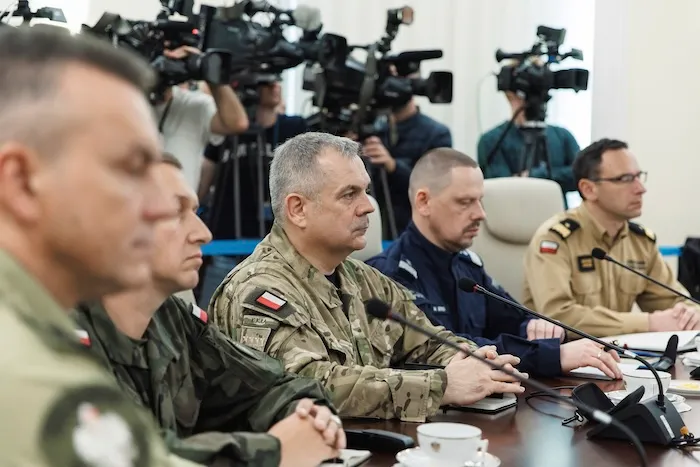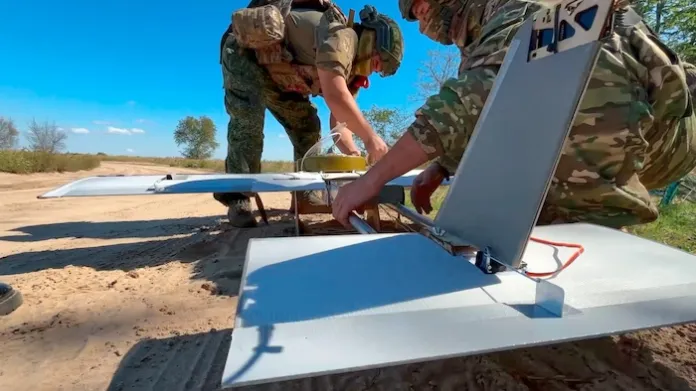European leaders are sounding the alarm about so-called hybrid Russian warfare over confirmed and suspected aerial incursions in recent weeks in several countries.
Russian drones have entered Polish and Romanian airspace, Russian fighter jets have entered Estonian airspace, a Russian jet flew over a German Navy frigate in the Baltic Sea, airports in Denmark and Norway had to shut down temporarily due to unknown drone activity, and Germany is investigating whether Russia was responsible for a mysterious swarm of drones caught spying on a power plant, hospital, and shipyard — all within the last month.
The first of these incidents occurred when Poland identified a drone incursion of unprecedented size on Sept. 9. It was not the first time Russian drones had entered NATO airspace, but the number of drones was unprecedented, and it was the first time NATO forces shot down possible threats in allied airspace.
The scrambling of NATO fighter jets to intercept the drones in Polish airspace was a stark example of how the alliance is currently using expensive weaponry to bring down much cheaper drones — a problem the United States faced with the Houthis in the Red Sea as well.
“This is a big deal,” retired Rear Adm. Mark Montgomery told the Washington Examiner. “It’s a question of, for three years we’ve been watching this unrelenting air campaign against Ukraine, and I don’t know that NATO has taken those three years as a great opportunity to prepare.”
European officials have discussed the concept of creating a “drone wall” on the eastern part of the continent, which would not be a literal wall but an integrated group of systems consisting of radar, acoustic sensors, and countermeasures to better detect and intercept small drones and swarms of drones.
“They still don’t have sufficient sensors, and they don’t have sufficient shooters along the whole border with Russia, and as a result, they have some late or no detections and no cost-effective way to really engage,” added Montgomery, who is now with the Foundation for Defense of Democracies. “What they have to do is they have to work on getting traditional sensors, like ground-based radars and dirigibles, untraditional ground-based radars, aircraft like [Airborne Warning and Control System]. Because that’s expensive stuff of which there are limited numbers,” they should pair it with “some passive sensors,” among other technologies.
There have been other incidents as well.

Latvian government websites were also temporarily unavailable on Thursday after the country was hit with a cyberattack, though its origin has not been identified, and an investigation is underway.
Russia also invested significantly, but unsuccessfully, in trying to sway the Moldovan elections last weekend for the party that wanted closer ties with Moscow. Instead, Moldovan President Maia Sandu, a pro-European leader, and the Party of Action and Solidarity won an overall majority of the vote.
Officials from Poland, Germany, and France said in a joint statement on Monday that there had been “unprecedented interference by Russia, including with vote-buying schemes and disinformation.”
These types of operations are commonly referred to as “hybrid warfare,” which are more stealthy attacks, acts of sabotage, cyberattacks, disinformation and misinformation, and more, instead of a more direct military conflict, like Russia is engaged in with Ukraine.
European leaders met in Copenhagen this week to discuss the threats from Russia.
Polish Prime Minister Donald Tusk warned Thursday that NATO allies need to abandon the “illusion” that “there is not war,” he said, adding that, “It’s a war — a new type of war, very complex, but it’s a war.”
He also revealed that Poland has experienced “new incidents in our region, in the Baltic Sea, every single week. It’s almost every day.” He did not elaborate, though a spokesperson for Poland’s Interior Ministry said a Russian vessel was spotted a little more than 300 yards from a pipeline that sends gas from a sea platform inland.
Similarly, Danish Prime Minister Mette Frederiksen warned that officials in Denmark have “seen how Russia has increased airspace violations and hybrid attacks in Europe with fighter jets and with drones, migrants being pushed across our borders, interference in democratic elections and cyberattacks targeting critical infrastructure,” adding, “Russia is testing us, and more than ever, we need to stand strong together.”
Moscow has denied involvement in these incidents, and Russian President Vladimir Putin mocked the European leaders’ concern on Thursday.
He said “European elites” are “whipping up the hysteria” about the “Russian threat,” during televised remarks at an international relations conference, adding that “it looks as if a war with the Russians is just around the corner: They keep repeating this mantra over and over again.”
Putin told the leaders to “calm down, sleep tight, and finally, deal with your own issues,” and he later insisted that Russia had “no aggressive intentions regarding other countries.”
European officials and experts have argued that Moscow is testing NATO’s resolve and defenses.
Gen. Jack Keane, a retired four-star Army general, told the Washington Examiner that the hybrid attacks in European countries are “complementing” Moscow’s strategic objectives in Ukraine.
“I think what is happening with the incursions in Poland, Romania, and Estonia are complementing those strategic objectives,” he said. “And by that, I mean Russia has the confidence to expand, No. 1, to test the response of the air defense and military systems in those countries, but moreover to test their resolve and the will of the Eastern Europeans of NATO writ large.”
Liana Fix, a senior fellow at the Council for Foreign Relations, argued that the Russian aerial incursions are distinct from Russia’s “gray-zone or hybrid activities,” and do not fall “under Russia’s general efforts to discourage Europeans from supporting Ukraine.”
EASTERN EUROPEAN LEADERS WARN OF CONTINUED RUSSIAN AGGRESSION
These drone incursions are “as black and white, and by black I mean Article 5, as you can get,” she told the Washington Examiner, referencing one of the NATO alliance’s bedrock principles that requires allies to view an attack against one of them as an attack on all members.
European leaders have also discussed the possibility of shooting down Russian aircraft that invade their airspace, though Fix is “concerned” because she said those comments offer “a great invitation for Russia to test the bluff and to see whether they actually do this, and to test whether the United States would actually stand behind Europeans doing that.”
, 2025-10-05 10:00:00,  , Washington Examiner, %%https://www.washingtonexaminer.com/wp-content/uploads/2023/11/cropped-favicon.png?w=32, https://www.washingtonexaminer.com/feed/, Mike Brest
, Washington Examiner, %%https://www.washingtonexaminer.com/wp-content/uploads/2023/11/cropped-favicon.png?w=32, https://www.washingtonexaminer.com/feed/, Mike Brest
